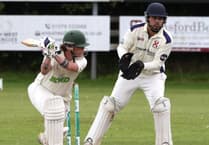IN spite of heavy rain, levels at some of the South West reservoirs still remain unseasonably low for the time of year, with South West Water introducing hosepipe bans in Cornwall and parts of Devon, writes Chris Hall.
However, this has had no adverse effect on the fishing at the South West Lakes Trout Fisheries, with the waters responding well to a rise in temperatures.
Kennick
Anglers averaged four fish per rod over the month, with most fish caught on either an intermediate line or floating line with a long sink-tip, and a variety of retrieval methods.
Fish were well spread out around the fishery, with boat anglers enjoying marginally better sport than those fishing from the bank. So far there have only been a few small buzzer hatches, and fish are not yet looking to the surface to feed; however, fish have been feeding eagerly, and a wide range of nymph and lure patterns have all caught well.
Geoff Vernon (from Okehampton) caught the best fish of the month – a 3lb rainbow as part of a bag on nine fish, all caught on buzzer and damsel patterns. Graham Read (from Christow) caught six rainbows to 2lb 8oz while fishing from the bank using an intermediate line and fast retrieve.
Simon Vowles and Andy Sterrick (from Exeter) caught 20 fish between them from a boat (long drifts) using buzzers on long leaders and floating lines, picking up fish on the mid-dropper and point.
Siblyback
Anglers averaged 4.2 fish per rod over the month, with most of the fish coming from Stocky Bay, Two Meadows, and Crylla Bay, as well as the deep water by the dam. A variety of retrieval methods worked well, mainly on slow sinking, intermediate, or floating lines with a long leader.
Montanas, Diawl Bachs, Black Buzzers, and Damsels proved to be the most successful nymph patterns, along with a wide variety of deeper fished lures. Simon Peters (from Cusgarne) caught the best bag of the month – 12 fish to 3lb, fishing from the bank, but requiring a long cast to get to feeding fish. Hawthorns have started to appear, but as yet, fish have not started to look to feed from the surface, but this will change as the temperatures rise.
Burrator
Levels are now full, with the best fishing to be had at Longstone Bank and Point, Pig Trough Bay, and The Lawns. Anglers have averaged 2.8 fish per rod, mainly on intermediate or floating lines with long leaders.
There have been the occasional rising fish (with the odd one being caught on a Black Gnat), but the majority of fish have been caught sub-surface on a wide selection of nymphs (Damsels, Diawl Bachs, and Black Buzzers proving popular) and lure patterns (Back Fritz, Boobies, Orange FAB). Paul Avery caught the best fish of the month – a 4lb overwintered rainbow, one of five fish caught from a float tube using a floating line. Luke Temple-Smith (from Plymouth) caught two blues to 2lb, and four rainbows to 3lb 8oz. Al Lawson (from Plymouth) caught 10 fish (three browns and seven rainbows) from a boat, using either a sinking line pulling a Damsel Nymph, or a Black Gnat fished on a floating line.
Stithians
Stithians is now 100% full, and fish are near the surface, so floating lines with a slow ‘figure of eight’ retrieve are the order of the day. The fishing picked up as the month progressed, with anglers averaging 4.3 fish by the end of April. Dry patterns achieved some success, with anglers catching on Black Hoppers, Black Gnats, Beetles, as well as Black and Peacock spiders fished in the surface film.
Sailing Club Bay, Hollis Bank, Mossops, and the deeper water by the dam produced the best sport.
Simon Peters (from Truro) caught four rainbows to 2lb using washing line set up on a floating line (FAB on the point, two black Cormorants on the droppers). Stephen Glanville (from St. Agnes) caught 10 rainbows in an evening session on dry patterns as the fish began to rise, sipping small black flies from the surface wind-lanes.
Fernworthy
Weekly returns at Fernworthy have ranged between 2.1 and 3.1 fish per rod, with intermediate or floating lines with a sink-tip producing the best catches. The South bank, particularly in the permit hut area, Lowton Bay, and Thornworthy Bay have seen the most activity, with fish starting to rise to midges, and a good buzzer hatch in the evening.
Dry patterns have worked well, with fish taking Black Hoppers, Black Gnats, Black Bits, and black emergers; deeper feeding fish have been taken on Damsel Nymphs, Brown Nymphs, buzzers, and a selection of dark lure patterns. Ed Bird (from Okehampton) caught two browns to 2lb 8oz using a Black Pennell, while Alan Judd (from Seaton) caught three browns to 2lb using an intermediate line and fast retrieve.
Andy Lawson (from Plymouth) caught a brace of browns casting a black Sparkle Hopper to rising fish.
Colliford
Water levels here are still low (64%), but rising slowly. The fishing has been challenging on some days, but better when the sun has shone and the air temperature risen.
Not many fish have been showing yet, and fish have all been caught sub-surface on nymph (Diawl Bach, Black Spider, Black nymph) or lure (Cormorant and Muddler) patterns.
Gillhouse Bay, the East Bank, and The Causeway have produced the best sport. Paul Mockford (from St Wenn) caught four browns to 25cm using a mini-muddler and black nymph patterns, while Downderry’s Steve Dean caught six browns using a Soldier Palmer from the East Bank.
Roadford
Now at 69% full, and slowly filling, Roadford continued to produce some excellent sport, with anglers averaging 7.1 fish per rod.
Grinnacombe, Daveys Bank, Shop Inlet, and north Gaddacombe Point proved to be the best locations, with floating or intermediate lines producing the best results.
A range of dark lures and nymph patterns all caught well, with no fish showing on the surface yet. The Fluff Chuckers Yeti event was held in early April, with 90 fish caught and successfully released.
Jack Welshman caught the longest fish by a couple of millimetres, while Simon Peters caught the most fish (16), narrowly beating Roger Truscott (15) and Wayne Thomas (14). The following week Steve Dean (from Downderry) caught 12 browns on a Soldier Palmer, as did Rodney Wevill (using a Soldier Palmer, Blue Zulu, and Humongous). Charles Langton (from Chagford) caught 18 browns over two sessions.





Comments
This article has no comments yet. Be the first to leave a comment.